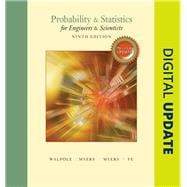ALERT: Before you purchase, check with your instructor or review your course syllabus to ensure that you select the correct ISBN. Several versions of Pearson's MyLab & Mastering products exist for each title, including customized versions for individual schools, and registrations are not transferable. In addition, you may need a CourseID, provided by your instructor, to register for and use Pearson's MyLab & Mastering products.
Student can use the URL and phone number below to help answer their questions:
http://247pearsoned.custhelp.com/app/home
800-677-6337
Packages
Access codes for Pearson's MyLab & Mastering products may not be included when purchasing or renting from companies other than Pearson; check with the seller before completing your purchase.
Used or rental books
If you rent or purchase a used book with an access code, the access code may have been redeemed previously and you may have to purchase a new access code.
Access codes
Access codes that are purchased from sellers other than Pearson carry a higher risk of being either the wrong ISBN or a previously redeemed code. Check with the seller prior to purchase.
This package includes MyStatLab®.
This classic text provides a rigorous introduction to basic probability theory and statistical inference, with a unique balance between theory and methodology. Interesting, relevant applications use real data from actual studies, showing how the concepts and methods can be used to solve problems in the field. This revision focuses on improved clarity and deeper understanding.
This latest edition is also available in as an enhanced Pearson eText. This exciting new version features an embedded version of StatCrunch, allowing students to analyze data sets while reading the book.
Personalize learning with MyStatLab
MyStatLab™ is an online homework, tutorial, and assessment program designed to work with this text to engage students and improve results. Within its structured environment, students practice what they learn, test their understanding, and pursue a personalized study plan that helps them absorb course material and understand difficult concepts.
0134468910 / 9780134468914 Probability & Statistics for Engineers & Scientists, MyStatLab Update with MyStatLab plus Pearson eText -- Access Card Package 9/e
Package consists of:
0134115856 / 9780134115856 Probability & Statistics for Engineers & Scientists, MyStatLab Update
0321847997 / 9780321847997 My StatLab Glue-in Access Card
032184839X / 9780321848390 MyStatLab Inside Sticker for Glue-In Packages









